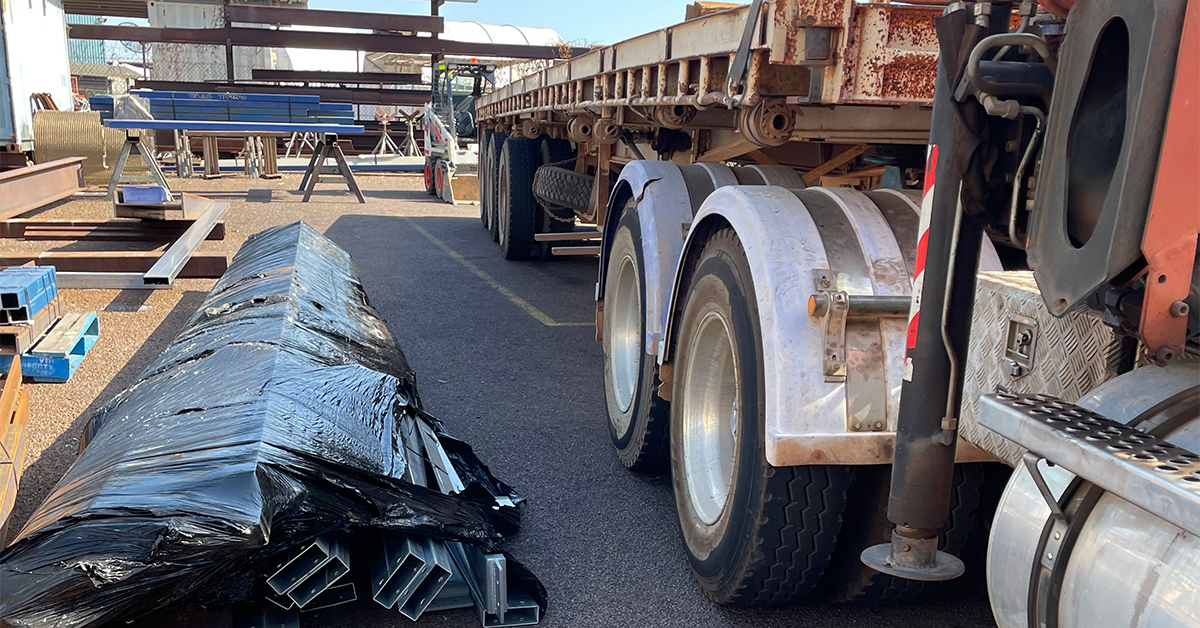Worker crushed by 1.2 tonne forklift load
The purpose of this Safety Alert is to highlight the risk of serious injury or death when using a forklift, especially when exclusion zones are not maintained around operating forklifts.
Background
A Darwin worker received severe injuries when he was crushed by a bundle of steel weighing over 1.2 tonnes.
The incident occurred last year as two workers were loading of bundles of steel onto a trailer using a forklift. The injured worker, who was a subcontractor, was acting as a spotter and standing on the opposite side of the trailer from the forklift, when a load slipped from the forklift tynes as it was being lowered.
Initial reports of the incident to NT WorkSafe indicated the worker had sustained life threatening injuries. Fortunately the worker survived but suffered multiple fractures throughout his body and was hospitalised for two months. The worker is still receiving medical treatment and faces months of rehabilitation.

Possible contributing factors
- The steel bundle was an awkward load, measuring approximately six meters in length, almost one meter in width and over 1.2 tonnes in weight. The bundle was also wrapped in plastic.
- The load was being lifted directly on the tynes (no pallet used) and the plastic wrap may have caused less friction between the load and the metal tynes.
- The forklift mast may have been tilted forward when the load was lowered, causing it to slip from the tynes.
- The forklift operator may have lost sight of the spotter, who had moved to stand near the load as it was being lowered.
Action required
- Carry out a risk assessment before commencing any work to identify the potential hazards and identify control measures to control the risk.
- Consider if there is a safer method to lift and load such an awkward load?
(E.g. using a jib attachment for the forklift or another item of plant).
- Consider if there is a safer method to lift and load such an awkward load?
- Develop and document safe work procedures for the task at hand and have them readily available for all workers and sub-contractors.
- Always conduct a prestart check before starting the forklift and once the forklift has started, check all the controls, pedals and brakes are operating correctly.
- The checklist on page 12 the Guide Forklift safety – reducing the risks can assist.
- If any damage or problems are noticed, isolate the forklift so it cannot be used and organise for a service or repairs.
- Loads that have the ability to slip, fall or roll off the forklift tynes or pallet should be appropriately restrained to prevent it from happening.
- Before operating the forklift that requires a spotter, the operator, spotter and any other workers involved in the task must establish a system of communication before any work starts, this system should:
- Stop workers (including the spotter) from approaching the forklift until the operator has established visual contact and has signalled that it is safe to approach.
- If an operator has signalled a worker to approach, the operator should, stop lower the load, apply the handbrake, and take their hands off the controls.
- If the operator loses sight of the worker, they should stop operations until they re-establish visual contact with the worker.
- Workers should never approach the forklift and assume that the operator can see them.
- Workers should never stand under or near a raised load in case of equipment malfunction or operator error.
Licence requirement for forklifts
The use of a forklift is considered high risk work and requires the operator to hold an appropriate licence to perform high risk work issued by NT WorkSafe or another Australian Work Health and Safety Regulator. It is an offence to operate a forklift without a licence or with an expired licence.
Further information
For further information, please refer to the following:
Code of Practice
Guidance publications
Disclaimer
This Safety Alert contains safety information following inquires made by NT WorkSafe about an incident or unsafe practice. The information contained in this Alert does not necessarily include the outcome of NT WorkSafe’s action with respect to an incident. NT WorkSafe does not warrant the information in this Alert is complete or up-to-date and does not accept any liability for the information in this report or as to its use.